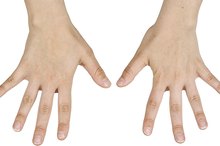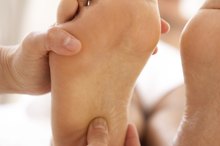What does fact checked mean?
At Healthfully, we strive to deliver objective content that is accurate and up-to-date. Our team periodically reviews articles in order to ensure content quality. The sources cited below consist of evidence from peer-reviewed journals, prominent medical organizations, academic associations, and government data.
The information contained on this site is for informational purposes only, and should not be used as a substitute for the advice of a professional health care provider. Please check with the appropriate physician regarding health questions and concerns. Although we strive to deliver accurate and up-to-date information, no guarantee to that effect is made.
Symptoms of Bone Spur in the Foot
A bone spur is a bony projection that occurs along the edges of bones in the body. The bone spurs themselves are not painful, but they can cause pain by rubbing against nerves and bones. Most bone spurs cause no symptoms and may remain hidden for years. Bone spurs seem to occur naturally without any health condition as a cause 1. Bone spurs on the foot causes chronic irritation to nerves, muscles, and foot bones. A bone spur on the foot is one of the most common orthopedic conditions.
Risk Factors
There are certain risk factors that are common to people who develop bone spurs. These risk factors include people with flat feet, extra-high arches, obesity, sudden weight gain and tight Achilles tendons. People who do a lot of running also tend to develop bone spurs.
Pain
Have Heel Spurs? How to Strap Your Foot
Learn More
Bone spurs in the foot is usually noticed because of pain that develops in the bottom of the foot. The pain is usually worse in the morning and improves throughout the day. This painful tenderness on the bottom of the foot may be replaced by a dull ache when the foot is rested.
Walking
A bone spur in the foot makes walking difficult. The pain increases when walking for a long period of time. Standing for a long period of time becomes more difficult as well with this type of bone spur.
Other Symptoms
What Is a Saddle Bone?
Learn More
Bone spurs tend to affect one foot. If the pain is in both feet then it is usually not caused by a bone spur. Mild swelling around the area with the bone spur usually occurs accompanied by redness.
Treatment
Bone spurs can get better with treatment. Anti-inflammatory medications can be prescribed. Physical therapy like heel stretching exercises can be done to help relieve the pain. Night splints and shoe inserts can also be worn. Sometimes a short leg cast can be worn for three to six weeks. This is a cast that resembles a ski boot and stops below the knee. Steroid injections are also an option for relief though they are very painful. If all the treatment options fail then the bone spur can be removed through surgery.
- Bone spurs can get better with treatment.
- If all the treatment options fail then the bone spur can be removed through surgery.
Related Articles
References
Writer Bio
Karen Carter spent three years as a technology specialist in the public school system and her writing has appeared in the "Willapa Harbor Herald" and the "Rogue College Byline." She has an Associate of Arts from Rogue Community College with a certificate in computer information systems.








